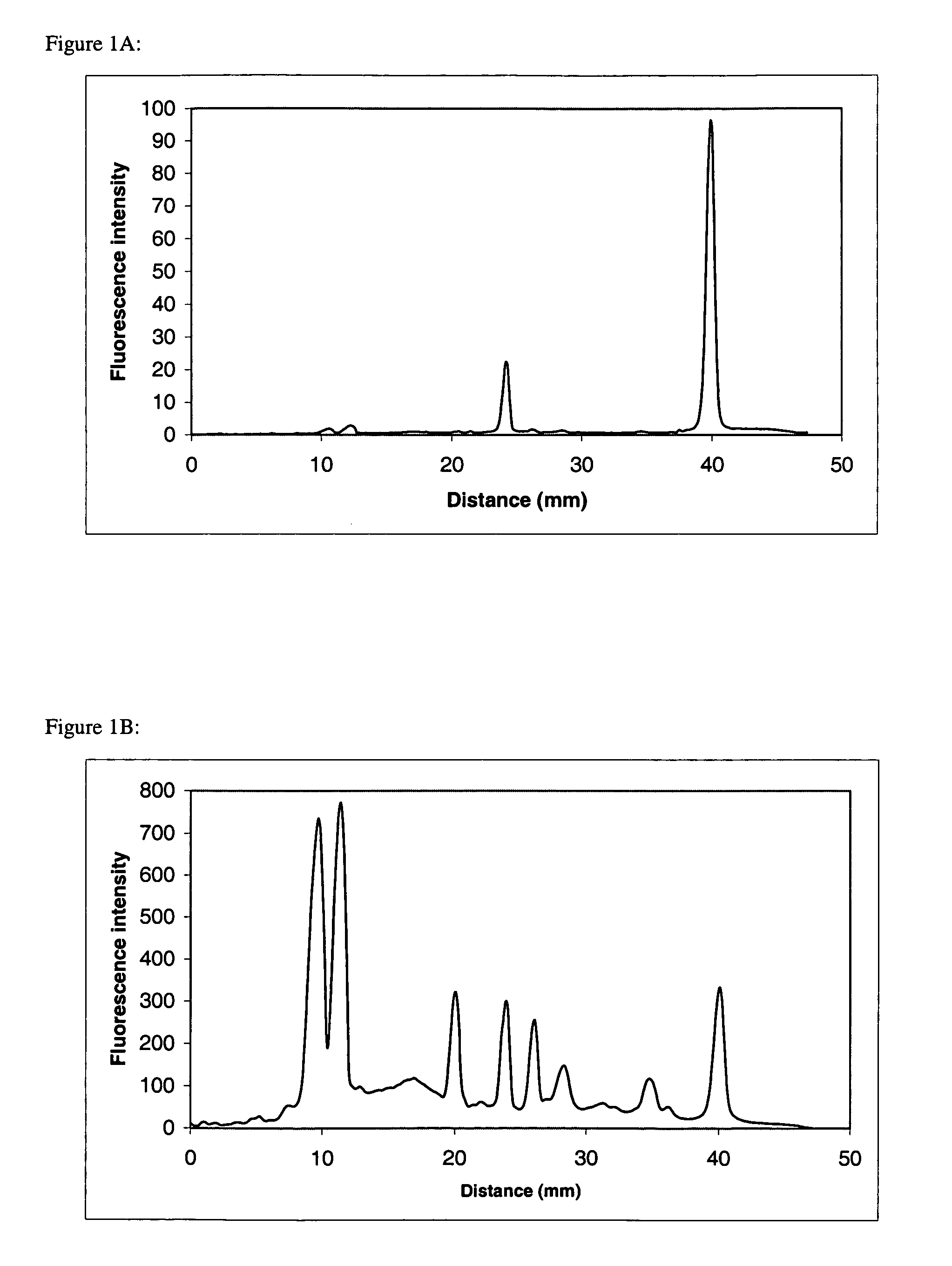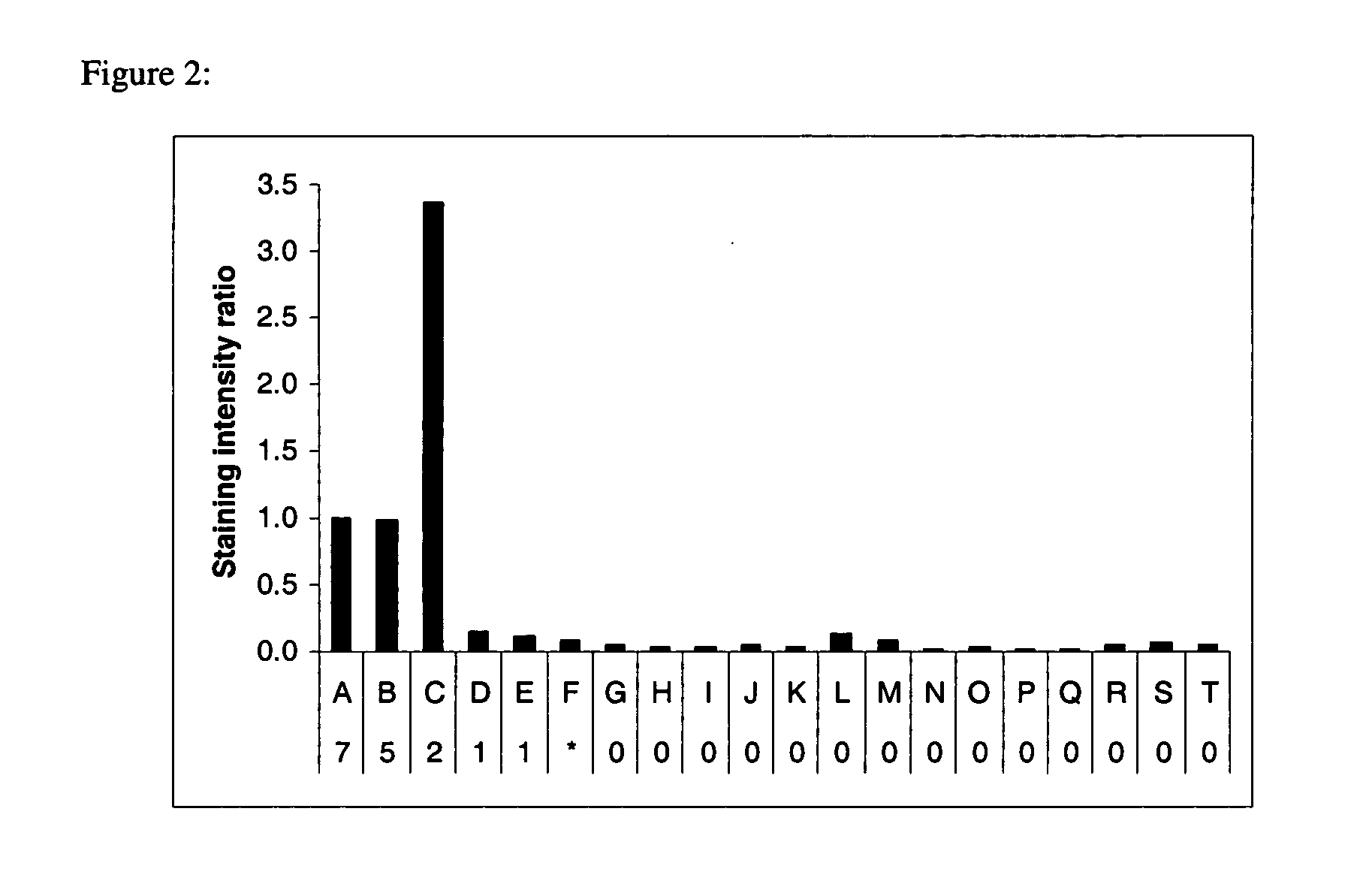Selective detection of proteins that contain two or more alpha-helical transmembrane domains
a technology of alpha-helical transmembrane and protein, applied in the direction of fluid pressure measurement, liquid/fluent solid measurement, peptides, etc., can solve the problems of streaking in the isoelectric focusing dimension, lack of hydrophobic proteins in the proteomic profile generated from two-dimensional gel electrophoresis (2dge), and poor resolution of this class of proteins
- Summary
- Abstract
- Description
- Claims
- Application Information
AI Technical Summary
Benefits of technology
Problems solved by technology
Method used
Image
Examples
example 1
Selective Staining of Proteins Containing Two or More Alpha Helical Transmembrane Domains in the Protein Complex F1F0 ATPase After Separation by SDS Polyacrylamide Gel Electrophoresis
[0153] The protein complex F1F0 ATPase consists of a water-soluble F1-ATPase complex of 5 subunits (α, β, γ, δ, ε) and an insoluble membrane-embedded F0 complex of 3 subunits (a,b, c). F1 ATPase does not contain proteins having transmembrane domains, while F0 a, b, and c subunits contain a 5,1, and 2 α-helical transmembrane domains, respectively. Purified F1F0 ATPase was dissolved in 1× SDS sample buffer (50 mM Tris, 10% glycerol, 100 mM DTT, 2% SDS, 0.2% bromophenol blue, pH 6.8). Proteins were separated by SDS-polyacrylamide gel electrophoresis utilizing 10-20% acrylamide Tris-glycine precast Ready gels (Bio-Rad Laboratories, Hercules, Calif.). The 1 mm thick, 8×8 cm gels were subjected to electrophoresis using the Bio-Rad Mini Protean III system according to standard procedures. Following separation...
example 2
Selective Staining of Proteins Containing Two or More Alpha Helical Transmembrane Domains After Separation by SDS Polyacrylamide Gel Electrophoresis
[0155] Representative examples of hydrophobic proteins containing no transmembrane domains, α helical transmembrane domains and a β sheet transmembrane domain along with water soluble proteins were prepared in 1×SDS sample buffer, separated by SDS-polyacrylamide gel electrophoresis, stained with Compound 4, imaged, stained for total proteins with SYPRO Ruby dye, and imaged again as described in Example 1. The intensity of the signals from Compound 4 and SYPRO Ruby stain was measured using ImageGauge software (Fuji Photo, Tokyo, Japan) for each protein and the ratio of the two signals was calculated and normalized for bacteriorhodopsin, a seven a helical transmembrane domain protein (FIG. 2). Proteins containing two or more a helical transmembrane domains were preferentially stained.
example 3
Selective Staining of Proteins Containing Two or More Alpha Helical Transmembrane Domains in the Protein Complex F1F0 ATPase After Separation by SDS Polyacrylamide Gel Electrophoresis
[0156] Bacteriorhodopsin, a seven α-helical transmembrane domain-containing protein, F1F0 ATPase complex, and a protein marker mixture containing myosin, β-galactosidase, phosphorylase b, BSA, ovalbumin, carbonic anhydrase, soybean trypsin inhibitor, lysozyme, and aprotinin (all non-transmembrane domain proteins) were prepared in 1× LDS sample buffer (50 mM Tris, 10% glycerol, 50 mM DTT, 2% LDS, 0.015% EDTA, 0.1% Serva Blue G250, and 0.1% Phenol Red, pH 8.5). Proteins were separated by SDS-polyacrylamide gel electrophoresis utilizing 4-12% acrylamide Bis-Tris NuPAGE precast gels (Invitrogen, Carlsbad, Calif.). The 1 mm thick, 8×8 cm gels were subjected to electrophoresis using the NuPAGE XCell Mini-Cell system according to standard procedures. Following separation, the gels were fixed 20 minutes in 100...
PUM
| Property | Measurement | Unit |
|---|---|---|
| Fraction | aaaaa | aaaaa |
| Fraction | aaaaa | aaaaa |
| Fraction | aaaaa | aaaaa |
Abstract
Description
Claims
Application Information
 Login to View More
Login to View More - R&D
- Intellectual Property
- Life Sciences
- Materials
- Tech Scout
- Unparalleled Data Quality
- Higher Quality Content
- 60% Fewer Hallucinations
Browse by: Latest US Patents, China's latest patents, Technical Efficacy Thesaurus, Application Domain, Technology Topic, Popular Technical Reports.
© 2025 PatSnap. All rights reserved.Legal|Privacy policy|Modern Slavery Act Transparency Statement|Sitemap|About US| Contact US: help@patsnap.com



